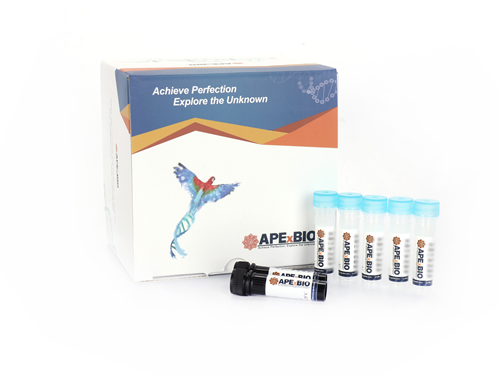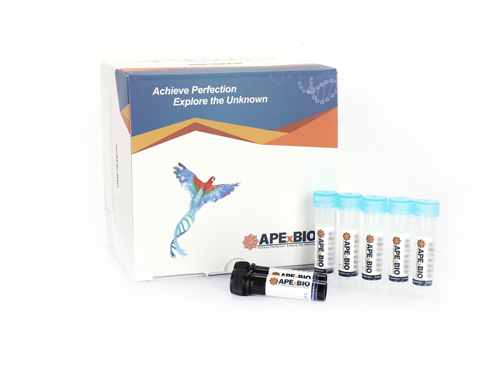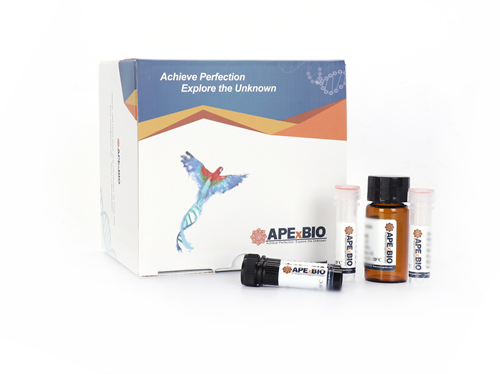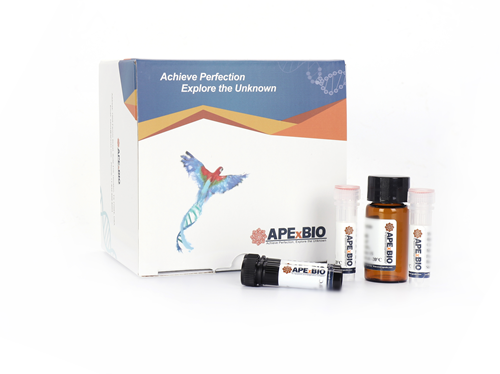EdU Imaging Kits (Cy3)
Measuring cell proliferation and cell cycle are a fundamental method to assess cell health, determine genotoxicity, and evaluate drug’s pharmacodynamic effect. The common method is measuring DNA synthesis directly. In previous experiments, there are several approaches such as the incorporation of radioactive nucleosides (3H-thymidine) or BrdU. Here, we introduce one new method, click chemistry - CuAAC (Copper-Catalyzed Azide-Alkyne Cycloaddition), and the use of this reaction in direct measurement of S-phase DNA synthesis in cell cycle. "Click Chemistry" is a term that was introduced by K. B. Sharpless in 2001, it’s a set of biocompatible small molecule reactions commonly used in bioconjugation, allowing the joining of substrates with specific biomolecules (such as a reporter molecule).
A nucleoside analog of thymidine, EdU (5-ethynyl-2’-deoxyuridine), can be incorporated into DNA strand during DNA synthesis. The alkynyl group of EdU is a biologically inert group that will undergo an extremely selective reaction with dye’s azido via a CuAAC reaction to afford an 1,2,3-triazole product. EdU and Cy3/Cy5 azide possess biologically unique moieties to fluorescently label DNA of proliferating cells, producing low backgrounds and high detection sensitivities. This CuAAC reaction affords superior regioselectivity and quantitative transformation under extremely mild conditions. The reaction is a highly efficient and can be used in a quantitative manner via Flow Cytometry or fluorescence microscope.
EdU is an ideal alternative of BrdU since it’s independent of harsh DNA denaturing conditions (typically using HCl, heat, or digestion with DNase). In BrdU-based assays, it requires extra DNA denaturation to expose the BrdU to an anti-BrdU antibody which is huge compared to fluorescent dye used in EdU-based assays. Unlike bulky antibodies, alkyne and azide groups are very small in size, therefore Cy3/Cy5 azide gain access to the DNA under standard aldehyde-based fixation and detergent permeabilization. Besides, BrdU-based method is time consuming and difficult to perform consistently, antibodies of BrdU can exhibit nonspecific binding. The harsh treatments necessary for this method can adversely affect sample integrity, cell morphology and image quality. Because of the mild reaction conditions in EdU-based assay, you can accurately determine cell proliferation while preserving cell morphology, DNA integrity, antigen binding sites. Preservation of DNA integrity allows for DNA staining, including staining with dyes used for cell cycle analysis.
Cy3 azide (Excitation maximum: 555 nm Emission maximum: 570 nm)
Cy5 azide (Excitation maximum: 646 nm Emission maximum: 662 nm)

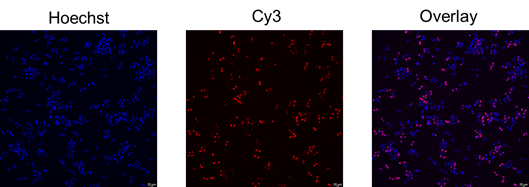
- 1. Bin Liu, Yansi Xian, et al. "Targeted Blockage of Pathological Extracellular Vesicles and Particles From Fibroblast-Like Synoviocytes for Osteoarthritis Relief: Proteomic Analysis and Cellular Effect." J Extracell Vesicles. 2025 Sep;14(9):e70162.
- 2. Yunfei Zou, Junyi Li, et al. "Empagliflozin alleviates doxorubicin-induced myocardial injury by inhibiting RIP3-dependent TLR4/MyD88/NF-κB signaling pathway." Volume 242, Part 1, December 2025, 117277
- 3. Wanwan Li, Qionggui Hu, et al. "A positive feedback loop between FOSB and miR-133b controls colon cancer cell proliferation." Acta Biochim Biophys Sin (Shanghai). 2025 Mar 26;57(8):1222-1233. PMID: 40151144
- 4. Han Xu, Xiaoyu Zhao, et al. "Regulation of Mitochondrial Metabolism by Mfn1 Gene Encoding Mitofusin Affects Cellular Proliferation and Histone Modification." Cells. 2025 Jul 2;14(13):1015 PMID: 40643535
- 5. BingJie Rui, YanFeng Yang, et al. "LINC02888 promotes HGSOC progression and immune evasion via PPIB-mediated stabilization of LAPTM5 mRNA and inhibition of RIG-I-like receptor signaling." J Transl Med. 2025 Jun 11;23(1):640 PMID: 40495222
- 6. Zekuan Xue, Dongdong Yang, et al. "IGF-1 secreted by mesenchymal stem cells affects the function of lymphatic endothelial progenitor cells: a potential strategy for the treatment of lymphedema." Front Genet. 2025 May 21:16:1584095 PMID: 40469882
- 7. Shi-Yi Wu, Zi-Mei Peng, et al. "SP1 promotes triple-negative breast cancer progression by targeting USP5." Cancer Cell Int. 2025 May 15;25(1):177 PMID: 40375299
- 8. Tao Wang, Xin-Hao Han, et al. "SIRT5-mediated BCAT1 desuccinylation and stabilization leads to ferroptosis insensitivity and promotes cell proliferation in glioma." Cell Death Dis. 2025 Apr 7;16(1):261. PMID: 40195331
- 9. Sintim Mui, Juanyi Shi, et al. "Multi-omics analysis identifies OSGEPL1 as an oncogene in hepatocellular carcinoma." Discov Oncol. 2025 Mar 16;16(1):328 PMID: 40090949
- 10. Dongni Shao Chen, Jin Man, et al. "Krüppel Regulates Cell Cycle Exit and Limits Adult Neurogenesis of Mushroom Body Neural Progenitors in Drosophila." bioRxiv. March 25, 2025.
- 11. Sintim Mui, Juanyi Shi, et al. "Multi-omics analysis identifies OSGEPL1 as an oncogene in hepatocellular carcinoma." Discov Onc 16, 328 (2025).
- 12. Wenhui Yang, Yilu Li, et al. "Mesenchymal stem cells overexpressing neuropeptide S promote the recovery of rats with spinal cord injury by activating the PI3K/AKT/GSK3β signaling pathway." Stem Cell Res Ther.2025 Feb 28;16(1):100. PMID: 40022159
- 13. Shan-Shan Wu, Xiao-Yu Zhao, et al. "Transcription coactivator YAP1 promotes CCND1/CDK6 expression, stimulating cell proliferation in cloned cattle placentas." Zool Res. 2025 Jan 18;46(1):122-138 PMID: 39846191
- 14. NING TANG, WODING DENG, et al. "Single-Cell Spatial–Temporal Analysis of ZNF451 in Mediating Drug Resistance and CD8+ T Cell Dysfunction." RESEARCH 12 Nov 2024.
- 15. ruijuan Gao, Aikeremu Nigala, et al. "Quercetin regulates pulmonary vascular remodeling in pulmonary hypertension through TGF-β1-Smad2/3 pathway." Research Square. 04 Oct, 2024
- 16. Ying Luo, Mengda Niu, et al. "Oncoproteins E6 and E7 upregulate topoisomerase I to activate the cGAS-PD-L1 pathway in cervical cancer development." Front Pharmacol. 2024 Aug 2:15:1450875. PMID: 39156107
- 17. Zhuo Lu, Xiao-Yu Wang, et al. "CHIP-mediated ubiquitin degradation of BCAT1 regulates glioma cell proliferation and temozolomide sensitivity." Cell Death Dis. 2024 Jul 29;15(7):538 PMID: 39075053
- 18. Jin Man, Xian Shu, et al. "The Conserved Transcription Factor Krüppel Regulates the Survival and Neurogenesis of Mushroom Body Neuroblasts in Drosophila Adult Brains." bioRxiv. June 26, 2024.
- 19. Bowen Hou, Min Shu, et al. "Unveiling the role of UPF3B in hepatocellular carcinoma: Potential therapeutic target." Cancer Sci. 2024 Jun 18. PMID: 38889220
- 20. Yixian Wang, Xin Li, et al. "Pathomics and single-cell analysis of papillary thyroid carcinoma reveal the pro-metastatic influence of cancer-associated fibroblasts." BMC Cancer. 2024 Jun 10;24(1):710. PMID: 38858612
- 21. Haotian Chen, Jing Wen, et al. "circKDM1A suppresses bladder cancer progression by sponging miR-889-3p/CPEB3 and stabilizing p53 mRNA." iScience. 2024 Mar 29;27(4):109624. PMID: 38632984
- 22. Yixian Wang, Xin Li, et al. "The Prognostic Value and Potential Immune Mechanisms of lncRNAs Related to Immunogenic Cell Death in Papillary Thyroid Carcinoma." J Inflamm Res. 2024 Mar 29:17:1995-2008. PMID: 38566983
- 23. Renru Luo, Qiongyu Liu, et al. "c-Rel is a Novel Oncogene in Lung Squamous Cell Carcinoma Regulating Cell Proliferation and Migration." J Cancer. 2024 Mar 4;15(8):2329-2339. PMID: 38495491
- 24. Yongfeng Sun, et al. "miR-140-y targets TCF4 to regulate the Wnt signaling pathway and promote embryonic feather follicle development in Hungarian white goose." Poult Sci. 2024 Apr;103(4):103508. PMID: 38350393
- 25. Jing Yang, et al. "Suppressing inflammatory signals and apoptosis-linked sphingolipid metabolism underlies therapeutic potential of Qing-Jin-Hua-Tan decoction against chronic obstructive pulmonary disease." Heliyon. 2024 Jan 18;10(3):e24336. PMID: 38318072
- 26. Wen Deng, Ru Chen, et al. "CircFSCN1 induces tumor progression and triggers epithelial–mesenchymal transition in bladder cancer through augmentation of MDM2-mediated p53 silencing." Cell Signal. 2023 Nov 20:114:110982. PMID: 37981069
- 27. Cheng Wei, Jishou Zhang, et al. "Resolvin D1 attenuates Ang II-induced hypertension in mice by inhibiting the proliferation, migration and phenotypic transformation of vascular smooth muscle cells by blocking the RhoA/mitogen-activated protein kinase pathway." J Hypertens. 2023 Nov 7. PMID: 37937508
- 28. Yue Wu, Yuansheng Duan, et al. "Deubiquitinase YOD1 suppresses tumor progression by stabilizing E3 ligase TRIM33 in head and neck squamous cell carcinoma." Cell Death Dis. 2023 Aug 12;14(8):517. PMID: 37573347
- 29. Yu Wang, Yuwen Zhu, et al. "Proteolytic activation of angiomotin by DDI2 promotes angiogenesis." EMBO J. 2023 Aug; 42(15): e112900. PMID: 37350545
- 30. Luyao Zhang, Yiran Wang, et al. "BEST1 Positive Monocytes in Circulation: Visualize Intratumoral Crosstalk between Cancer Cells and Monocytes." Adv Sci (Weinh). 2023 Jun;10(17):e2205915. PMID: 37088729
- 31. Xiaowu Ma, Hongkai Zhuang, et al. "SLC39A1 Overexpression is Associated with Immune Infiltration in Hepatocellular Carcinoma and Promotes Its Malignant Progression." J Hepatocell Carcinoma. 2022 Feb 15;9:83-98. PMID: 35211427
- 32. Hanfeng Wang, Yang Fan, et al. "Loss of CMTM6 promotes DNA damage-induced cellular senescence and antitumor immunity." Oncoimmunology. 2022 Jan 5;11(1):2011673. PMID: 35024247
Related Biological Data

Related Biological Data
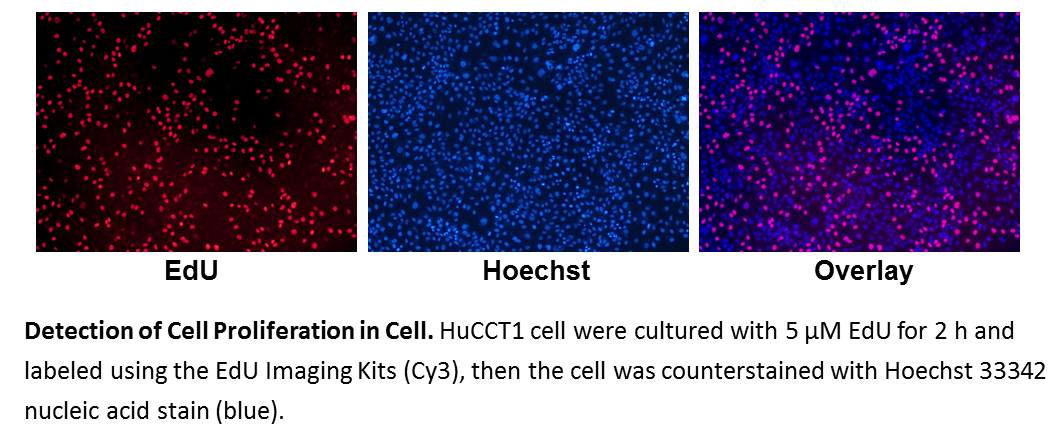
| Components | 50-500 Tests |
| EdU (Component A) | 5 mg |
| Cy3 Azide (Component B) | 1 vial |
| DMSO (Component C) | 4 mL |
| 10X EdU Reaction Buffer (Component D) | 4 mL |
| CuSO4 (100 mM Aqueous Solution) (Component E) | 1 vial |
| EdU Buffer Additive (Component F) | 400 mg |
| Hoechst 33342 (10 mg/mL in Water) (Component G) | 35 uL |
Store the kit at -20ºC away from light and moisture, stable for 1 year. | |
Simple works in less time with no denaturation steps or harsh treatment
High efficiency with robust brightness
Providing better preservation of cell morphology, antigen structure, and DNA integrity
High consistency because of independence of variable BrdU-antibody



